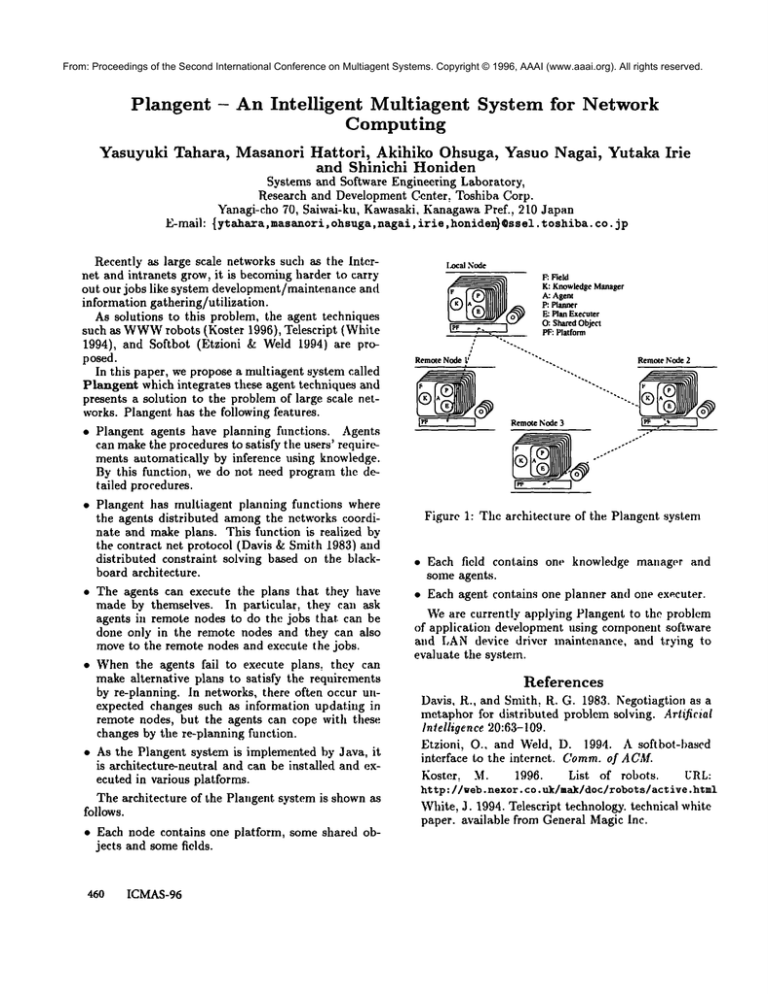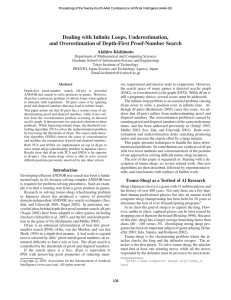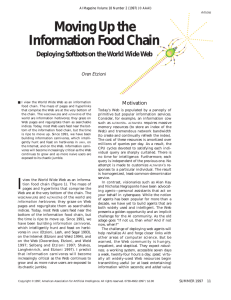
From: Proceedings of the Second International Conference on Multiagent Systems. Copyright © 1996, AAAI (www.aaai.org). All rights reserved.
Plangent
- An Intelligent
Multiagent
Computing
System
for
Network
Yasuyuki Tahara, Masanori Hattori, Akihiko Ohsuga, Yasuo Nagai, Yutaka Irie
and Shinichi
Honiden
Systems and Software Engineering Laboratory,
Research and Development Center, Toshiba Corp.
Yanagi-cho 70, Saiwai-ku, Kawasaki, KanagawaPref., 210 Japan
E-mail:
{ ytahara,
masanori,
ohsuga,
nagai,irie,honide~
@ssel.toshiba,
co.j p
Recently as large scale networks such as tile Internet and intranets grow, it is becomingharder to carry
out our jobs like system development/maintenance and
information gathering/utilization.
As solutions to this problem, the agent techniques
such as WWW
robots (Koster 1996), Telescript (White
1994), and Softbot (Etzioni & Weld 1994) are proposed.
In this paper, we propose a rnuhiagent system called
Plangent which integrates these agent techniques and
presents a solution to the problem of large scale networks. Plangent. has the following features.
* Plangent agents have planning flmctions. Agents
can makethe procedures to satisfy tile users’ requirements automatically by inference using knowledge.
By this function., we do not need program the detailed procedures.
¯ Plangent has rnultiagent planning functions where
the agents distributed amongthe networks coordinate and make plans. This function is realized by
the contract net protocol (Davis & Smith 1983) and
distributed constraint solving based on the blackboard architecture.
¯ The agents can execute the plans that they have
made by themselves. In particular,
they can ask
agents in remote nodes to do the jobs that. can be
done only in the remote nodes and they can also
moveto the remote nodes and execute the jobs.
¯ Whenthe agents fail to execute plans, they can
make alternative plans to satisfy the requirements
by re-planning. In networks, there often occur unexpected changes such as information updating in
remote nodes, but the agents can cope with these
changes by tim re-planning function.
¯ As the Plangent system is implemented by :lava, it
is architecture-neutral and can be installed and executed in various platforms.
The architecture of the Plangent system is shownas
follows.
¯ Each node contains one platform, some shared objects and somefields.
460
ICMAS-96
l.oeal
Node
ON.
F: Field
K: Knowledge Manager
A: Agent
P: Planner
E: Plan Executer
O: Shared Object
PF: Platform
!
Remote Node 1,:
"" "-
Remote Node 2
Remote Node 3
. .-
.°o
.o°"
. oo***
j..
Figure 1: The architecture
of the Plangent system
¯ Each field contains on,, knowledge manager and
some agents.
¯ Each agent contains one planner and one executer.
Weare currently applying Plangent to the problem
of application development using component software
and LANdevice driver maintenance, and trying to
evaluate the system.
References
Davis, R., and Smith, R. G. 1983. Negotiagtion as a
metaphor for distributed problem solving. Artificial
Intelligence 20:63-109.
Etzioni, O., and Weld, D. 1994. A softbot-based
interface to the internct. Comm.of ACM.
Koster, M.
1996.
List of robots.
URL:
http://web.nexor.co.uk/mak/doc/robots/ac~ive.ht
White, J. 1994. Telescript technology, technical white
paper, available from General Magic Inc.






